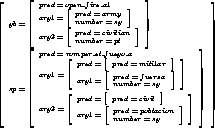


Next: Reversible Unification Grammars Up: Reversible Unification Based Machine Previous: Introduction
Unification-based Transfer
In this section I will give some examples of the use of a unification grammar
(in PATR II [17] notation) to define the relation between language dependent
logical forms.
For illustrative purposes I will assume logical forms are represented by feature
structures consisting of the attributes  ,
,  ,
,  together with
some attributes representing `universal' meanings such as tense, aspect,
number and person; I will not touch upon issues such as quantification and
modification. The logical forms of English and Spanish are labeled by the
attributes
together with
some attributes representing `universal' meanings such as tense, aspect,
number and person; I will not touch upon issues such as quantification and
modification. The logical forms of English and Spanish are labeled by the
attributes  and
and  respectively.
As an example the logical form of `The army opened fire at the civilians'
is represented as in figure 1.
respectively.
As an example the logical form of `The army opened fire at the civilians'
is represented as in figure 1.

Figure 1: An example of a logical form
Such feature structures will often be related in a straightforward way to
a Spanish equivalent, except for the value of the  attributes.
A very simple rule in PATR II style may look as in figure 2.
attributes.
A very simple rule in PATR II style may look as in figure 2.
This rule simply states that the translation of a logical form is composed of the translation
of its arguments. If the rule applies to the feature structure in 1 the three
daughters of the rule will be instantiated as in figure 3, and the value of
 will be bound to the
will be bound to the  values of these daughters.
values of these daughters.

Figure 3: Three instantiations
An example of the rule for the first daughter will be a lexical entry and looks as in figure 4.
A lexical entrylexical
0 
 0 gb
0 gb = open_fire_at
= open_fire_at
 0 sp
0 sp = romper_el_fuego_a
The simple English expression `army' has to be translated as a complex
expression in Spanish: `fuerza militar'. The rule will look as in 5 where it is
assumed that the construction is analyzed in Spanish as an ordinary noun-adjective construction,
and where the logical form of the adjective takes the logical form of
the noun as its argument.
A rule for `fuerza militar'army
0
= romper_el_fuego_a
The simple English expression `army' has to be translated as a complex
expression in Spanish: `fuerza militar'. The rule will look as in 5 where it is
assumed that the construction is analyzed in Spanish as an ordinary noun-adjective construction,
and where the logical form of the adjective takes the logical form of
the noun as its argument.
A rule for `fuerza militar'army
0 
 0 gb pred
0 gb pred = army
= army
 0 sp pred pred
0 sp pred pred = militar
= militar
 0 sp arg1 pred
0 sp arg1 pred = fuerza
= fuerza
 0 sp arg1 number
0 sp arg1 number =
=  0 gb number
0 gb number The translation for `civilian' is defined in a similar rule (although the translation of
`number' is different).
Note that this example of complex transfer is similar to the famous `schimmel - grey horse'
cases.
As a result of the rule applications the feature structure in figure 1
will get instantiated to the feature structure in 6,
from which the generator generates the
string `La fuerza militar rompio el fuego a la poblacion civil'.
The translation for `civilian' is defined in a similar rule (although the translation of
`number' is different).
Note that this example of complex transfer is similar to the famous `schimmel - grey horse'
cases.
As a result of the rule applications the feature structure in figure 1
will get instantiated to the feature structure in 6,
from which the generator generates the
string `La fuerza militar rompio el fuego a la poblacion civil'.

Figure 6: The feature structure after transfer
In the foregoing examples the relation between logical forms is rather
straightforward. Note however that the full power of a unification
grammar can be used to settle more difficult translation cases, because
different attributes can be used to represent the `translational syntax'. For instance
we can build a tree as value of the attribute  to represent the derivational
history of the translation process. Or we can `thread' information through
different nodes to be able to make translations dependent on each other.
Translation parameters such as style and subject field can be percolated
as attributes of nodes to obtain consistent translations; but these
attributes themselves need not be translated.
to represent the derivational
history of the translation process. Or we can `thread' information through
different nodes to be able to make translations dependent on each other.
Translation parameters such as style and subject field can be percolated
as attributes of nodes to obtain consistent translations; but these
attributes themselves need not be translated.



Next: Reversible Unification Grammars Up: Reversible Unification Based Machine Previous: Introduction
Gertjan van Noord
Fri Nov 25 13:42:02 MET 1994
